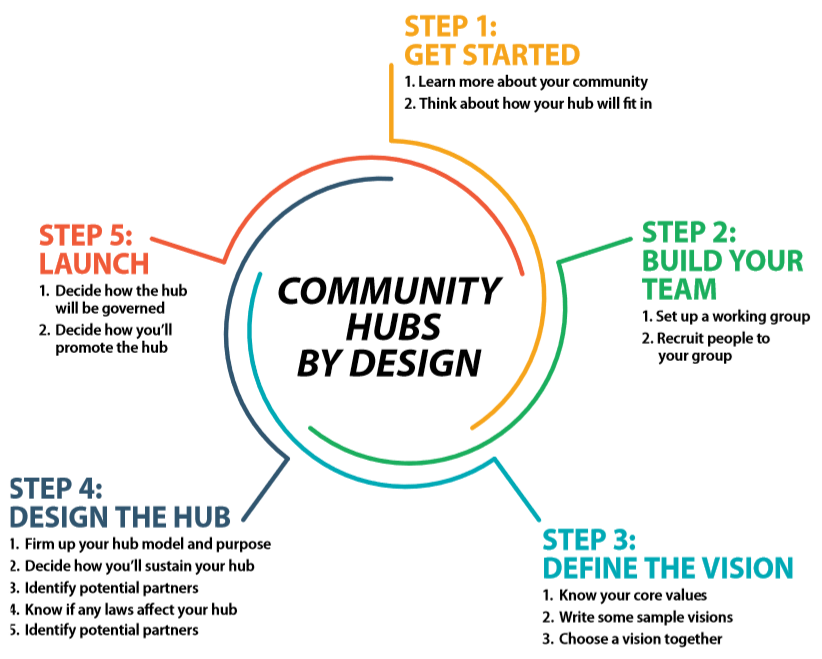MAKING A HUB
WHAT IS A COMMUNITY HUB?
A community hub is somewhere people can go to make friends, pursue common interests and find support when they need it. It's a place that's welcoming, inclusive and connecting.
A hub is a space that:
Meets many needs
Helps those who need it improve their community
Has more than one purpose
Is open to everyone who is part of the community
Is created by the community, for the community
You can learn about how to make a hub in more detail by downloading our Community Hubs by Design Toolkit. For a brief overview of the process, keep reading!
THE GOLDEN RULE OF HUB-MAKING: ENGAGE, ENGAGE, ENGAGE
The whole point of creating a hub is to have people participate in it. That means they need to know it's available and that it offers something they want to be part of. That's why engagement is important: talking to people, listening to what they have to say, reflecting their input, and encouraging them to take action when the time comes.
step by step
STEP 1: GET STARTED
Because community hubs are a reflection of the community itself, the starting point is really a single question: "What do we want to do?"
Sometimes the answer will be obvious and personal: "I want a place where other new Canadians like me can get together and talk about our experiences living in a different country." Other times it may be more rooted in a community need. "I want to provide a space where people can get help with their banking outside of business hours so they don't have to miss work or neglect their finances."
The idea for your hub may come from understanding the history of the community, what's been done before, what worked (or didn't) in the past. The deeper your knowledge, the more options you'll discover for what your hub can become.
step 2: build your team
Whether your hub is simple or complex, there's no need to build it alone. This step will help you find people to get up and running.
A good way to meet like-minded people is to get involved in other community groups and activities. You'll not only make connections but also build relationships -- and trust. Those things don't happen all at once, so be patient be prepared to put some time in.
step 3: define the vision
A vision represents hope for the future and inspires action to turn that hope into real change. This step will help your group define a vision for the hub.
The most important thing is for your vision to be authentic, inspiring and a genuine expression of your community's wishes and aspirations. Here are examples of some Calgary organizations' visions to serve as models:
Carya Society of Calgary: Confident individuals, strong families and engaged communities for generations.
Ethno-Cultural Council of Calgary: Calgary is a just and equitable society for all.
Calgary Can: Bottle pickers are valued and compensated for their environmental and economic contributions.
Bowness Community Association: Bowness; a vibrant, engaged, sustainable community of choice.
As you can see, each vision is set in the present tense, worded as though it has already come true. This helps people imagine what the future will be like if the vision does come true.
step 4: DESIGN THE HUB
There's a lot to think about when you get down to designing how your hub will work -- from location to funding to any special equipment you might need. This step will help you make sure all the right things are in place.
step 5: LAUNCH
You're nearly there! This step will help you make the final decisions about your hub so you can share it with the wider community.
All the information and feedback you've gathered, the plans you've developed, the relationships you've built and the partnerships you've established will help you in your push to launch day. At this point you should have all of the funding and any other resources you need to run the hub and any services it might offer.

